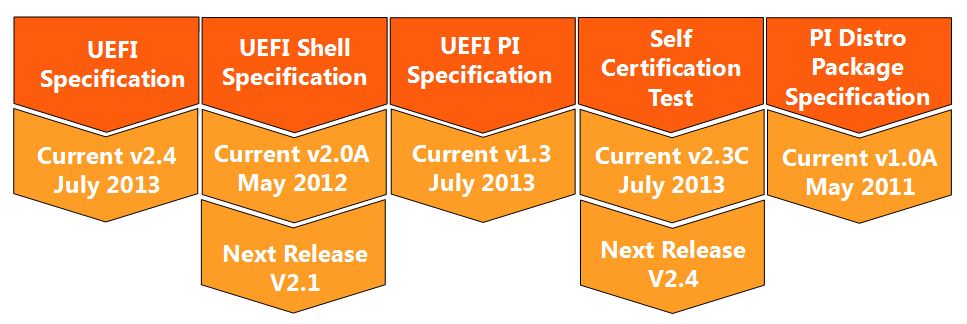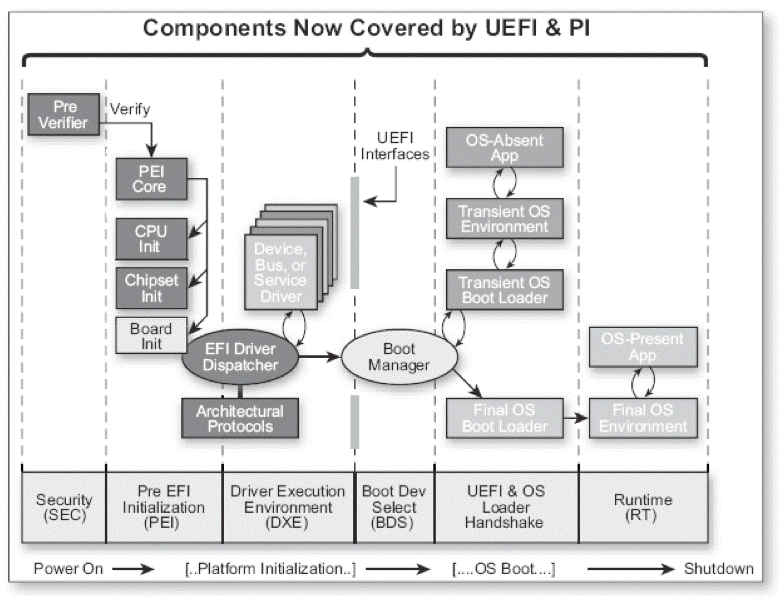UEFI - Aah, I heard ... but still, what is it?
UEFI - look ahead ( part 1/3 )
Not so long ago, I had to deal with what UEFI is and what it is eaten with. The topic is very relevant, and there are not very many articles in Russian. Well, I will try to correct the situation and share information that I managed to “dig up.” For a start, an introductory chapter to familiarize yourself with what UEFI is and why it is needed.
UEFI (Unified Extensible Firmware Interface) is the connecting shell between the operating system and hardware (hardware). In the future, it is planned that UEFI will completely replace the BIOS (Basic Input Output System) and take its place. UEFI is a relatively old technology developed in the 2005 (Unified EFI Forum) year. However, this statement is incorrect regarding this situation, since despite the fact that 8 years are quite a long time for IT technologies and in other areas, they managed to change several technologies at once, the UEFI initially developed rather slowly and only in recent years getting more and more famous. Below you can see the schedule of UEFI releases.

')
The primary goal in creating UEFI was to develop a convenient and multi-faceted shell for 64-bit systems with a more developed user interface and network control.
So, what are the advantages of UEFI?
Benefits and interesting facts about UEFI
It seems to me that all the benefits and advantages of switching from BIOS to UEFI will open up to users and developers only with the massive introduction of the shell and the complete abandonment of the BIOS. However, now you can list several obvious advantages of UEFI:
1) In connection with the latest trends, more and more PCs have a 64-bit OS, which allows for increased performance.
2) The second important point is memory addressing. A great opportunity to use more RAM and drive size. Theoretically, the maximum hard disk size can reach 8192 Exybyte , which is approximately 8.8 (oh yes! O_o) trillion terabytes, which even with the current volumes of information transfer is a very impressive figure, especially considering that the size of the archive of the entire Internet is 10 petabytes. As for the RAM, there are also bright prospects with the ability to address up to 16 Exybytes , which, given the current market situation (new PCs usually have from 8 to 16 GB of RAM) is a good starting point for the future.
The link to interesting facts is connected with a vivid example of whether it is a lot or a little.
3) Faster loading of the system, achieved through parallel initialization of individual components of the system.
4) Download drivers in UEFI and the subsequent transfer of these to the OS.
5) One of the most important and most critical features of UEFI is the Secure Boot Option , which allows you to protect Bootloader from the execution of malicious programs, which in turn allows you to protect the OS beyond its limits during boot. To do this, use "digital" signatures of operating systems.
UEFI Start
As shown in the following picture, the start of UEFI is divided into several different modules and stages, which in turn are divided into further subitems.

It all starts with the Power On phase (who would have thought) in which the Power On Self Test is performed and the Security phase skips. After that, we can assume that the platform is initialized, and we must not forget about the PEI phase (Pre-Initialization of EFI), as well as the DXE (Driver Execution Environment) phase, which allows the system to get to the point when memory becomes available, and also begins (Firmware) search for a boot device. In the BDS (Boot Device Selection) phase, a device is searched for from which the boot can be carried out, while a third-party device or UEFI-Shel l can be used. When the system starts, the already initialized and loaded drivers are transferred to the OS, in order to reduce the load time.
And so it was the introductory part of the UEFI story. The next chapter will examine the individual phases in more detail: POWER ON, SECURITY (SEC), PRE-EFI Initialisation (PEI), DRIVER EXECUTION ENVIRONMENT and BOOT DEV SELECT (BDS)
Source: https://habr.com/ru/post/203966/
All Articles